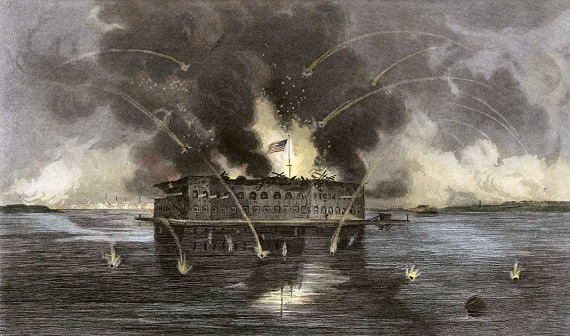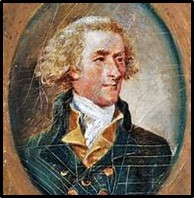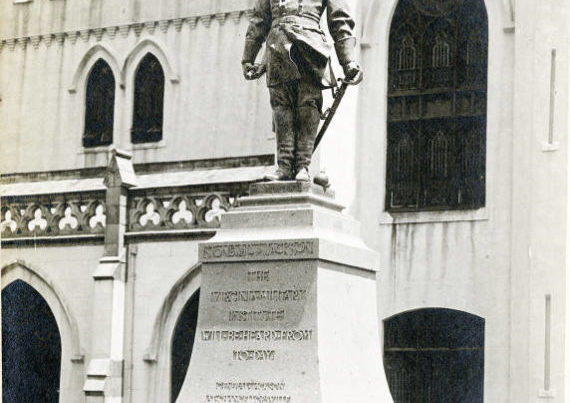In my article from last week entitled “1865 and Modern Relevance” I asserted that the outcome of the War for Southern Independence was as relevant today as it was 150 years ago. Just a few days after publication an incident involving Clemson University proved this point.
A group of atheists calling itself the “Freedom From Religion Foundation” has leveled allegations against the Clemson University Football Program and its Head Coach, Dabo Swinney, claiming that the school is sanctioning “unconstitutional” Bible studies and this, supposedly, creates an atmosphere of “religious coercion.”
I’ve known Dabo Swinney personally for close to 30 years. We played football together in high school, and I graduated with his older brother. Next month, my sons will be attending his football camp in Clemson for their second consecutive year. Dabo is a man of exemplary character, and I can attest that these accusations are patently absurd. But they are absurd in another way as well- they are “constitutionally” absurd.
The basis for the so-called “separation of Church and State” has its roots in the post-bellum “ratification” of the 14th Amendment. Most legal scholars believe that it “incorporates” the Bill of Rights into the State constitutions. It is from this latter doctrine, the “incorporation doctrine”, that the supposed “separation of church and State” stems. Professor Forrest McDonald, an acknowledged and renowned expert on the Constitution and the Founding period, has explained in detail why the 14th Amendment was never legally ratified and has done so far more capably than I could. What I want to discuss is the notion that public universities violate the Constitution by providing Bible studies, employing chaplains and promoting other such religious undertakings.
To begin with, the Constitution, which created the general government, was sold to the States on the basis that it encompassed only the specifically delegated powers that are enumerated within its text. James Wilson, Alexander Hamilton, James Madison and other proponents of the Constitution argued for ratification on this basis. Madison, for his part, had proposed a federal “negative” (veto power) over State laws at various times throughout the Philadelphia Convention. On each attempt he was rebuffed.
When a bill of rights was demanded—principally by George Mason of Virginia—Madison, Wilson, and Hamilton among others all argued that it was unnecessary, again asserting that the Constitution delegated only specific, enumerated powers to the general government.
For example, on 6 October 1787 Wilson said the following in regard to a bill of rights:
It will be proper … to mark the leading discrimination between the State constitutions and the constitution of the United States. When the people established the powers of legislation under their separate governments, they invested their representatives with every right and authority which they did not in explicit terms reserve; and therefore upon every question respecting the jurisdiction of the House of Assembly, if the frame of government is silent, the jurisdiction is efficient and complete. But in delegating federal powers, another criterion was necessarily introduced, and the congressional power is to be collected, not from tacit implication, but from the positive grant expressed in the instrument of the union. Hence, it is evident, that in the former case everything which is not reserved is given; but in the latter the reverse of the proposition prevails, and everything which is not given is reserved.
This distinction being recognized, will furnish an answer to those who think the omission of a bill of rights a defect in the proposed constitution; for it would have been superfluous and absurd to have stipulated with a federal body of our own creation, that we should enjoy those privileges of which we are not divested, either by the intention or the act that has brought the body into existence.
In plain English, if a power is not expressly delegated, the general government has no authority to exercise that power and thus a bill of rights would become redundant. Hamilton and Wilson even submitted that a bill of rights would enlarge, not restrict, the powers of the general government.
Wilson used freedom of the press as an example: “that very declaration might have been construed to imply that some degree of power was given, since we undertook to define its extent.”
Nonetheless, the States insisted on a bill of rights in general, and the future 9th and 10th Amendments in particular, and it became evident that the Constitution would not be ratified without these additions. The 10th Amendment was an express statement which declared what Wilson said was already implied, that being that “the powers not delegated to the United States by the Constitution, nor prohibited by it to the States, were reserved to the States.” In short, if a power is not enumerated specifically in Article I, Section 8, then the general government cannot exercise that power, as it is “reserved to the States.”
After hammering out what would become the Bill of Rights, Madison proposed in the first Congress to have the Bill of Rights applied to the States. His suggestion, as with the federal “veto” over States laws, was rejected unanimously. The Bill of Rights were intended as a check against potential encroachments by the general government only. They were not applicable against the States.
The Preamble to the Bill of Rights, which most people do not even know exists, states the following and clearly illustrates that the Bill of Rights only applied to the general government:
The conventions of a number of the States, having at the time of their adopting the constitution, expressed a desire, in order to prevent misconstruction or abuse of its powers, that further declaratory and restrictive clauses should be added: and as extending the ground of public confidence in the government, will best insure the beneficent ends of its institution.
In general, I do not like to refer to Supreme Court rulings as evidence to support a constitutional point. This is because, as you will see, the federal courts have themselves played a significant role in undermining original intent, as their actions more often than not stray far from the basis upon which the constitution or subsequent amendments were ratified. But even a blind squirrel can find a nut once in a while. Such is the case in Barron vs Baltimore in 1833. In that ruling, nationalist John Marshall stated that the first ten “amendments contain no expression indicating an intention to apply them to the State governments. This court cannot so apply them.”
So, there you have it. The Bill of Rights was adopted to restrict Federal power, not State and local. Even Marshall, who played a significant role in trying to undermine the actual results of the Philadelphia Convention, had to admit that the Bill of Rights did not act as a restriction of State and local power- it applied only to the general government.
It was not until the 20th Century that the Bill of Rights was applied against the States, beginning in 1925 with Gitlow vs New York. It took almost 60 years after the “reconstruction” era’s 14th Amendment was declared “ratified” for the Court to begin to magically “find” that the “Due Process Clause” and the “Privileges and Immunities Clause” of that amendment incorporated the Bill of Rights into the State constitutions. One of the major problems with this is that “incorporation” was never even discussed in the ratification process of the 14th Amendment. If one studies the legislative process of the ratification of that amendment and the records of the 39th Congress, they will see that the primary purpose of the 14th Amendment was to codify the 1866 Civil Rights Act, which defined “privileges and immunities” as a “right to life, liberty and property” (and nothing else) into the Constitution so that a future Congress could not overturn that Act.
Incorporation has been fabricated out of thin air as a means to further erode the original intent of the founding generation. It has allowed the general government to usurp State power. It is from this process that we have yet another “magical” discovery by the Supreme Court, the so-called “separation of Church and State.”
When the Bill of Rights was ratified, three States (New Hampshire, Connecticut and Massachusetts) had official State denominations. These State denominations would all remain intact well after the Bill of Rights was ratified. Its adoption did not change this, because it had no power to; it was a restriction of only Federal power.
The “incorporation doctrine”, along with the so-called “Separation of Church and State” culminated, at first, with the Court decision in Everson v. Board of Education (1947), and later with Engel vs Vitale (1962). Professor Kevin Gutzman explains that the motive behind the Everson ruling was that an ex-Ku Klux Klansman, Hugo Black, had been appointed Chief Justice of the Supreme Court. The Klan re-emerged in the 1920s and began to target Jews and Catholics. The Klan, in an effort to deny Federal support to Catholic schools, began to push for a “wall of separation” of Church and State. Failing to persuade the people to amend the Constitution through the proper constitutional channels, the Supreme Court, guided by Black, simply “amended” it from the bench. Voila! The Klan, with the aid of the Supreme Court, achieved its goal.
Two points should be taken from this. One is that “reconstruction” did not actually end in the 1870s as some suggest, and two, it was a reconstruction, not of the South alone, but of our entire governing system. Whereas we once had a Constitution that clearly defined the limits of Federal authority, our laws are now arbitrary and exist at the whim of 546 men and women in Washington D.C., some of whom are unelected.
One result of “incorporation” has been a massive increase in attacks on religion to the extent that now even municipalities, who were previously not restricted by the Bill of Rights, are forbidden from having Nativity scenes on their lawns, schools are attacked for even the most ecumenical prayers in class rooms, and student athletes who voluntarily attend prayer services and Bible studies in the State of South Carolina are told, by a group in another State some 800 miles away, that they are in violation of a clause that appears nowhere in the Constitution and was in fact fabricated out of thin air.
The President of the so-called “Freedom From Religion Foundation” appeared on a news show to explain that he was simply “trying to uphold the Constitutional rights of the student body.” The version of the “Constitution” that he claims to be trying to uphold was never adopted, or even agreed to, by the people of these United States. It was flatly rejected. That Constitution does not actually exist, except by authoritarian means. What these folks are really trying to do is use the Federal Courts to impose their will on people of another State. In its original form, the Constitution forbade such meddling.
While admitting that not a single player has filed a complaint with them, this “Foundation” has falsely accused Coach Swinney of the implied threat of limiting the playing time of athletes who do not attend Bible study. In other words, they are suggesting that Coach Swinney is a bully. Thinking people can see through this charade and easily discern the real bullies in this situation are found in Wisconsin, not Clemson, SC.







